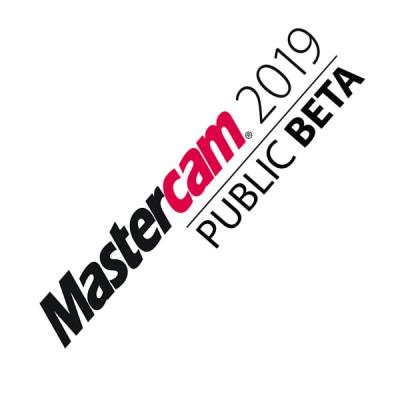
Mastercam 2019 Public Beta is now open to all currently maintained Mastercam customers. Shops all over the world, from small job shops to Fortune 100, get a chance to test-drive Mastercam 2019 before it is released and provide valuable feedback to help shape the final product. Participants in the Public Beta get an early look at dozens of powerful new tools for simple to complex jobs.
Here are a few things in Mastercam 2019 Beta:
- New 2D/3D Milling Features improve toolpath efficiency and control. Automate 2D chamfering and multiaxis deburring operations. Accelerated Finishing is expanded with taper and lens-style tool support.
- Surface and Solid Modeling Improvements simplify CAD for CAM and deliver greater design and geometry editing tools for shop-floor programmers.
- Powerful Turning and Mill-Turn improve your productivity with new plunge/grooving strategies, additional PrimeTurning support, expanded 3D tool and holder support, plus bar feed and import/export operation improvements.
- Improved Validation with new, advanced toolpath display and analysis, plus improvements to machine simulation and support.
- Streamlined workflow and graphics with new sectional views, level and planes management.
Contact Details
Related Glossary Terms
- chamfering
chamfering
Machining a bevel on a workpiece or tool; improves a tool’s entrance into the cut.
- computer-aided design ( CAD)
computer-aided design ( CAD)
Product-design functions performed with the help of computers and special software.
- computer-aided manufacturing ( CAM)
computer-aided manufacturing ( CAM)
Use of computers to control machining and manufacturing processes.
- feed
feed
Rate of change of position of the tool as a whole, relative to the workpiece while cutting.
- gang cutting ( milling)
gang cutting ( milling)
Machining with several cutters mounted on a single arbor, generally for simultaneous cutting.
- milling
milling
Machining operation in which metal or other material is removed by applying power to a rotating cutter. In vertical milling, the cutting tool is mounted vertically on the spindle. In horizontal milling, the cutting tool is mounted horizontally, either directly on the spindle or on an arbor. Horizontal milling is further broken down into conventional milling, where the cutter rotates opposite the direction of feed, or “up” into the workpiece; and climb milling, where the cutter rotates in the direction of feed, or “down” into the workpiece. Milling operations include plane or surface milling, endmilling, facemilling, angle milling, form milling and profiling.
- toolpath( cutter path)
toolpath( cutter path)
2-D or 3-D path generated by program code or a CAM system and followed by tool when machining a part.
- turning
turning
Workpiece is held in a chuck, mounted on a face plate or secured between centers and rotated while a cutting tool, normally a single-point tool, is fed into it along its periphery or across its end or face. Takes the form of straight turning (cutting along the periphery of the workpiece); taper turning (creating a taper); step turning (turning different-size diameters on the same work); chamfering (beveling an edge or shoulder); facing (cutting on an end); turning threads (usually external but can be internal); roughing (high-volume metal removal); and finishing (final light cuts). Performed on lathes, turning centers, chucking machines, automatic screw machines and similar machines.
